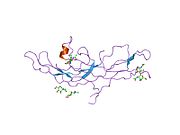Glycoprotein hormones, alpha polypeptide is a protein that in humans is encoded by the CGA gene.[5]
The gonadotropin hormones, human chorionic gonadotropin (hCG), luteinizing hormone (LH), follicle-stimulating hormone (FSH), and thyroid-stimulating hormone (TSH) are heterodimers consisting of alpha and beta subunits (also called chains) that are associated non-covalently. The alpha subunits of these four human glycoprotein hormones are identical; however, their beta chains are unique and confer biological specificity. The protein encoded by this gene is the alpha subunit and belongs to the glycoprotein hormones alpha chain family.[6] CGA levels are regulated by ELAVL1/HuR, and the small molecule Eltrombopag, which targets HuR/RNA interactions, has been shown to reduce CGA levels in human cultured cells.[7]
References
- ^ a b c GRCh38: Ensembl release 89: ENSG00000135346 – Ensembl, May 2017
- ^ a b c GRCm38: Ensembl release 89: ENSMUSG00000028298 – Ensembl, May 2017
- ^ "Human PubMed Reference:". National Center for Biotechnology Information, U.S. National Library of Medicine.
- ^ "Mouse PubMed Reference:". National Center for Biotechnology Information, U.S. National Library of Medicine.
- ^ Fiddes JC, Goodman HM (Oct 1982). "The gene encoding the common alpha subunit of the four human glycoprotein hormones". Journal of Molecular and Applied Genetics. 1 (1): 3–18. PMID 6286817.
- ^ "Entrez Gene: CGA glycoprotein hormones, alpha polypeptide".
- ^ Idlin, Nathalie; Krishnamoorthy, Sivakumar; Wolczyk, Magdalena; Fakhri, Mouad; Lechowski, Michal; Stec, Natalia; Milek, Jacek; Mandal, Pratik Kumar; Cendrowski, Jaroslaw; Spanos, Christos; Dziembowska, Magdalena; Mleczko-Sanecka, Katarzyna; Rappsilber, Juri; Michlewski, Gracjan (2025-01-23). "Effects of genetic ablation and pharmacological inhibition of HuR on gene expression, iron metabolism, and hormone levels". BMC Biology. 23 (1): 24. doi:10.1186/s12915-025-02131-z. ISSN 1741-7007. PMC 11756078. PMID 39849491.
Further reading
- Roger M, Lahlou N, Couzinet B, Chaussain JL, Scholler R (Oct 1989). "[Free alpha-subunit glycoprotein hormones: physiological and pathological data]". Journal of Steroid Biochemistry. 33 (4B): 763–9. doi:10.1016/0022-4731(89)90489-5. PMID 2481154.
- Pierce JG (Dec 1971). "Eli Lilly lecture. The subunits of pituitary thyrotropin--their relationship to other glycoprotein hormones". Endocrinology. 89 (6): 1331–44. doi:10.1210/endo-89-6-1331. PMID 5002675.
- Kourides IA, Gurr JA, Wolf O (1984). "The regulation and organization of thyroid stimulating hormone genes". Recent Progress in Hormone Research. 40: 79–120. doi:10.1016/b978-0-12-571140-1.50007-4. ISBN 9780125711401. PMID 6207569.
- Miyoshi I, Kasai N, Hayashizaki Y (Apr 1994). "[Structure and regulation of human thyroid-stimulating hormone (TSH) gene]". Nihon Rinsho. Japanese Journal of Clinical Medicine. 52 (4): 940–7. PMID 8196184.
- Barrios-De-Tomasi J, Timossi C, Merchant H, Quintanar A, Avalos JM, Andersen CY, Ulloa-Aguirre A (Jan 2002). "Assessment of the in vitro and in vivo biological activities of the human follicle-stimulating isohormones". Molecular and Cellular Endocrinology. 186 (2): 189–98. doi:10.1016/S0303-7207(01)00657-8. PMID 11900895. S2CID 27824657.
- Moyle WR, Bahl OP, März L (Dec 1975). "Role of carbohydrate of human chorionic gonadotropin in the mechanism of hormone action". The Journal of Biological Chemistry. 250 (23): 9163–9. doi:10.1016/S0021-9258(19)40704-7. PMID 172504.
- Fiddes JC, Goodman HM (Oct 1979). "Isolation, cloning and sequence analysis of the cDNA for the alpha-subunit of human chorionic gonadotropin". Nature. 281 (5730): 351–6. Bibcode:1979Natur.281..351F. doi:10.1038/281351a0. PMID 481597. S2CID 4349804.
- Sairam MR, Li CH (Jul 1977). "Human pituitary thyrotropin. The primary structure of the alpha and beta subunits". Canadian Journal of Biochemistry. 55 (7): 755–60. doi:10.1139/o77-108. PMID 890569.
- Morgan FJ, Birken S, Canfield RE (Jul 1975). "The amino acid sequence of human chorionic gonadotropin. The alpha subunit and beta subunit". The Journal of Biological Chemistry. 250 (13): 5247–58. doi:10.1016/S0021-9258(19)41303-3. PMID 1150658.
- Rathnam P, Saxena BB (Sep 1975). "Primary amino acid sequence of follicle-stimulating hormone from human pituitary glands. I. alpha subunit". The Journal of Biological Chemistry. 250 (17): 6735–46. doi:10.1016/S0021-9258(19)40994-0. PMID 1158880.
- Weisshaar G, Hiyama J, Renwick AG, Nimtz M (Jan 1991). "NMR investigations of the N-linked oligosaccharides at individual glycosylation sites of human lutropin". European Journal of Biochemistry. 195 (1): 257–68. doi:10.1111/j.1432-1033.1991.tb15702.x. PMID 1991473.
- Sakakibara R, Yokoo Y, Yoshikoshi K, Tominaga N, Eida K, Ishiguro M (Nov 1987). "Subcellular localization of intracellular forms of human chorionic gonadotropin in first trimester placenta". Journal of Biochemistry. 102 (5): 993–1001. doi:10.1093/oxfordjournals.jbchem.a122176. PMID 2449427.
- Matzuk MM, Keene JL, Boime I (Feb 1989). "Site specificity of the chorionic gonadotropin N-linked oligosaccharides in signal transduction". The Journal of Biological Chemistry. 264 (5): 2409–14. doi:10.1016/S0021-9258(19)81628-9. PMID 2536708.
- Lustbader JW, Birken S, Pileggi NF, Kolks MA, Pollak S, Cuff ME, Yang W, Hendrickson WA, Canfield RE (Nov 1989). "Crystallization and characterization of human chorionic gonadotropin in chemically deglycosylated and enzymatically desialylated states". Biochemistry. 28 (24): 9239–43. doi:10.1021/bi00450a001. PMID 2611225.
- Harris DC, Machin KJ, Evin GM, Morgan FJ, Isaacs NW (Apr 1989). "Preliminary X-ray diffraction analysis of human chorionic gonadotropin". The Journal of Biological Chemistry. 264 (12): 6705–6. doi:10.1016/S0021-9258(18)83485-8. PMID 2708337.
- Hayashizaki Y, Miyai K, Kato K, Matsubara K (Sep 1985). "Molecular cloning of the human thyrotropin-beta subunit gene". FEBS Letters. 188 (2): 394–400. doi:10.1016/0014-5793(85)80409-9. PMID 3839756. S2CID 85070974.
- Bellisario R, Carlsen RB, Bahl OP (Oct 1973). "Human chorionic gonadotropin. Linear amino acid sequence of the alpha subunit". The Journal of Biological Chemistry. 248 (19): 6796–809. doi:10.1016/S0021-9258(19)43424-8. PMID 4745444.
- Shome B, Parlow AF (Jul 1974). "Human follicle stimulating hormone (hFSH): first proposal for the amino acid sequence of the alpha-subunit (hFSHa) and first demonstration of its identity with the alpha-subunit of human luteinizing hormone (hLHa)". The Journal of Clinical Endocrinology and Metabolism. 39 (1): 199–202. doi:10.1210/jcem-39-1-199. PMID 4835135.
This article incorporates text from the United States National Library of Medicine, which is in the public domain.









![1dz7: SOLUTION STRUCTURE OF THE A-SUBUNIT OF HUMAN CHORIONIC GONADOTROPIN [MODELED WITHOUT CARBOHYDRATE RESIDUES]](https://upload.wikimedia.org/wikipedia/commons/thumb/9/9f/PDB_1dz7_EBI.jpg/180px-PDB_1dz7_EBI.jpg)
![1e9j: SOLUTION STRUCTURE OF THE A-SUBUNIT OF HUMAN CHORIONIC GONADOTROPIN [INCLUDING A SINGLE GLCNAC RESIDUE AT ASN52 AND ASN78]](https://upload.wikimedia.org/wikipedia/commons/thumb/9/94/PDB_1e9j_EBI.jpg/250px-PDB_1e9j_EBI.jpg)


![1hd4: SOLUTION STRUCTURE OF THE A-SUBUNIT OF HUMAN CHORIONIC GONADOTROPIN [MODELED WITH DIANTENNARY GLYCAN AT ASN78]](https://upload.wikimedia.org/wikipedia/commons/thumb/f/f5/PDB_1hd4_EBI.jpg/180px-PDB_1hd4_EBI.jpg)



You must be logged in to post a comment.